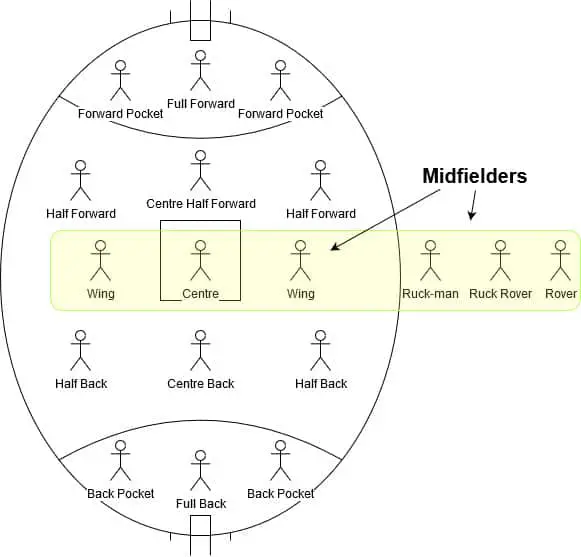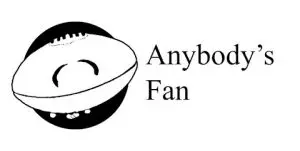When I played footy as a kid, one year our coach asked us all to write on a piece of paper what position we’d like to play. Every single kid had the same answer: Midfield. While I never had made it to a professional midfield position, I still learnt a lot about playing midfield.
As a fan of the modern game though, playing midfield has changed. Some of the modern midfield tactics, especially at the professional level, can be a bit confusing. I put this guide together, based on my own experience and research, to help explain some of modern AFL’s midfield tactics.
In short: Midfield AFL players play in the centre line or as followers. Their objective is to get the ball to their teammates after a stoppage, particularly a ball up. They accomplish this with a variety of tactics related to the location of midfielders, particularly wingers, and the overall skill of the midfielders.

In this guide I’ve looked further at:
- What the midfield positions are (centre line and followers)
- Difference between inside midfielders and outside (strategies for moving the ball along after a ball up)
- What stoppages are and what tactics teams employ after a stoppage
What are the midfield positions
There are two types of midfield positions:
- Centre line
- Followers
The centre line midfielders include the two wings and the centre. The centre player traditionally stands in the centre square with the wingers playing on either side. This gives the team width to their attacks.
The followers are the ruck-man, the ruck rover, and the rover. The ruck-man contests the ball up at the start of the game, start of quarters, after a goal, or when there is a stoppage (read on below for what a stoppage is). I’ve seen teams usually put one of the taller players as the ruck-man.
A ruck rover and a rover accompany the ruck-man as followers. The ruck rover and rover clear the ball after the ruck-man contests the ball up. When a ruck-man contests a ball up, his objective is to target the ruck rover and rover with a winning tap.

I wrote guides for the forwards and defenders as well, check them out here: anybodysfan.com/afl-forwards-a-guide/ and anybodysfan.com/afl-defenders-guide/.
Difference between inside midfielders and outside midfielders
There are two types of midfielders in in footy: Inside midfielders and Outside midfielders. Inside midfielders aim to move through contested areas to get the ball into space for their teammates; outside midfielders are the ones who occupy this space to receive the ball.
While there are not official AFL positions, I’ve found teams like to divide their midfielders like this to accommodate the different strengths within a team.
Inside midfielders are the ones who do the dirty work – so to speak. They are usually big and physical, winning the ball after the ruck-man has contested the ball-up.
While not usually quick, inside midfielders have great endurance and are able to take many hits and tackles over a game and a season. One of the great strengths of the inside midfielder is to have great vision – releasing players in heavy traffic and putting the ball into space for their teammates.
Outside midfielders are the main benefactors of the work of the inside midfielder. Outside midfielders are the targets usually out in space, like a receiver in American football. These guys are usually quicker than the inside midfielders, but also have great endurance having to run back and forth.
While they don’t score as heavily as forwards, outside midfielders are usually the main source of providing scoring opportunities. They are the ones kicking into the attacking players. Having good kick and clean skills is essential for an outside midfielder.
What is a stoppage?
A stoppage is when the ball comes to a halt and the umpires have to restart play. Stoppages can occur by the ball going out of play, after a goal, or the ball coming to a stop via a player being tackled.
There are three types of stoppages, these are:
- Centre bounce
- Boundary throw-in
- Around the ground ball-ups
Centre bounces occur at the start of quarters and after a goal has been kicked. Only 4 players are allowed inside the centre square at the bounce: The Ruck-man – who contests the ball in the air; the Rover; the Ruck Rover; and the Centre. These players are a crucial part of the game and winning the centre square clearance can be a massive advantage – it gives the team first use of the ball and the emphasis to attack.
Boundary throw-in is when the ball goes out of play either on the bounce or off the hands of players. Unlike the centre bounce, there are no restrictions on how many players can be around the throw-in. Having a good ruck-man who can tap the ball into space to his teammates is a great advantage.
Around the ground ball-ups are when a player is tackled and the ball stops moving yet there is no need for a free kick. To get the ball moving again the umpire will throw the ball up. Like throw-ins, there is no restriction on how many players can be around the ball. A great tap ruck-man – due to the high traffic of players – is really valuable here if he can give first use of the ball to his smaller players.
Common Tactics at a Stoppage
Most tactics for stoppages are aimed at the high levels of AFL play. I’ve found a couple to share that apply equally well from high level AFL down to the juniors. These tactics include:
| Centre Bounce | Usually focused on the wingers outside the square. Option 1: Have both wingers on one side of the square rather than the typical one on each. This gives more players on one side of the field – the ruck-man taps to this side. Option 2: Have one of the wingers at the back of the square to provide defensive cover. |
| Around the ground ball-ups and throw-ins | Try to overwhelm the opposition by bringing more players up to where the ball is. This is usually done by sacrificing one of the forwards by pushing them up the ground to try and out number the opposition. The sacrifice is that you then leave your attackers out numbered by defenders. |
At the highest levels of AFL, players will be coached like clockwork to carry out set plays. These plays include where they should be standing, where to run, and where the ruck-man will try to aim the tap.
What is a Clearance
A clearance is when the ball is won cleanly from a stoppage. It is usually the role of the inside midfielder to win the ball under physical pressure and to distribute the ball to his quicker outside midfielders.
What is a Disposal?
A disposal is a kick or handball to move the football along with the intention of passing getting the ball to another player. The more disposals a player has, the more they are gaining distance and retaining the ball for their team.
For a midfielder, is is important they get as many disposals as possible. A key performance indicator for a midfielder is how many disposals they can gain throughout a match. Midfielders are the engine room for the team and their performance needs to reflect this.
What is Disposal Efficiency
Disposal efficiency refers to the percentage of total disposals that either directly result in a score or find a teammate.
While getting a lot of disposals is one measure in judging midfielders performance, the other is how damaging they are with the ball. Disposal Efficiency is a good way of measuring this.
A player who may get 30 disposals but has a disposal efficiency of 50% – that is, less than half of their disposals make it to a goal or a teammate – may not be as damaging to the opponent as a player who has 20 disposals but an efficiency above 70%.
Teams are always trying to find the balance between quantity of disposals and quality of disposals. That balance can be measured by disposal efficiency.
Bottom Line
Midfielders have become increasingly important in a modern footy game. With forwards not always camping the forward half of the ground, and defenders not always sticking solely to the forward they are manning, midfielders play an important role in the tactics of play.
I see wingers especially as the utility piece that’s moved around to different parts of the ground – playing that ever important tactical role. Even centre-men are no longer directed to stick to position and act more as a follower, like an extra ruck rover. Positional play is also less common.
There is one thing though that hasn’t changed: The ability for a damaging midfielder to change the contest. Whether it be a big bodied inside midfielder winning clearance after clearance – giving his outisde players first use of the ball; or a skily smooth, fast outside midfielder feeding the ball into his team’s attacks.
A midfielder can run the opposition into the ground and change the opposing team’s tactics if he is continually getting a large amount of disposals.
The midfield is where every kid wants to play, but only the best do. Midfielders require speed, endurance, strength, quick thinking, sharp reflexes, great vision, and skill!
References
While I had my shot at playing midfield when I was young, I never had the chance to play professionally. To help put this guide together I used the following references:
- AFL positions
- McLeod, Andrew; Jaques, Trevor (2006). Australian football: steps to success (2nd ed.). Human Kinetics (Page 129). ISBN: 9780873226707
- Opinion piece on midfielders
- Youth coach manual on AFL tactics [PDF]
- An explanation of stoppages
- Centre bounce stoppages
- Boundary umpire handbook[PDF]
- A good explanation I found of starting and re-starting play
- Presentation on tactics and game plans [PDF]
- AFL explanation of stats
- AFLW definitions
Cass used to play junior footy when he was younger. He aimed to play midfield professionally but ended up pursuing other things. Cass sees midfielders as the heart and soul of the footy team.
